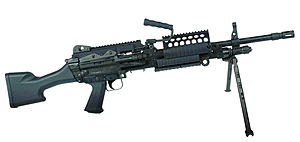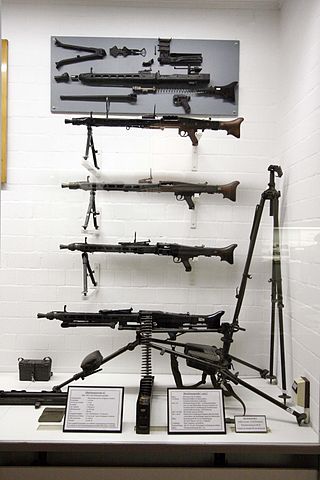
A general-purpose machine gun (GPMG) is an air-cooled, usually belt-fed machine gun that can be adapted flexibly to various tactical roles for light and medium machine guns. A GPMG typically features a quick-change barrel design calibered for various fully powered cartridges such as the 7.62×51mm NATO, 7.62×54mmR, 7.5×54mm French, 7.5×55mm Swiss and 7.92×57mm Mauser, and be configured for mounting to different stabilizing platforms from bipods and tripods to vehicles, aircraft, boats and fortifications, usually as an infantry support weapon or squad automatic weapon.
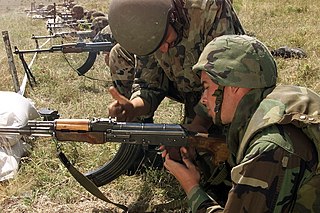
A squad automatic weapon (SAW), also known as a section automatic weapon or light support weapon (LSW), is a man-portable automatic firearm attached to infantry squads or sections as a source of rapid direct firepower. Weapons fulfilling this role can be light machine guns, or modified selective-fire rifles fitted with a heavier barrel, bipod and a belt/drum-fed design.
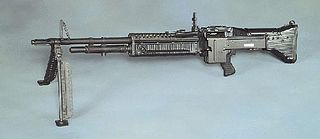
The M60, officially the Machine Gun, Caliber 7.62 mm, M60, is a family of American general-purpose machine guns firing 7.62×51mm NATO cartridges from a disintegrating belt of M13 links. There are several types of ammunition approved for use in the M60, including ball, tracer, and armor-piercing rounds.

The M240 machine gun, officially the Machine Gun, 7.62 mm, M240, is the U.S. military designation for the FN MAG, a family of belt-fed, gas-operated medium machine guns that chamber the 7.62×51mm NATO cartridge.

The FN Minimi is a Belgian 5.56mm or 7.62mm light machine gun, also classified as a squad automatic weapon developed by Ernest Vervier for FN Herstal. Introduced in the late 1970s, it is in service in more than 75 countries. The weapon is manufactured at the FN facility in Herstal and their U.S. subsidiary FN Manufacturing LLC.

The FN MAG is a Belgian 7.62 mm general-purpose machine gun, designed in the early 1950s at Fabrique Nationale (FN) by Ernest Vervier. It has been used by more than 80 countries and it has been made under licence in several countries, including Argentina, Canada, Egypt, India, and the United Kingdom.
The FNSCAR is a family of gas-operated short-stroke gas piston automatic rifles developed by Belgian manufacturer FN Herstal (FN) in 2004. It is constructed with modularity for the United States Special Operations Command (SOCOM) to satisfy the requirements of the SCAR competition. This family of rifles consists of two main types. The SCAR-L, for "light", is chambered in 5.56×45mm NATO and the SCAR-H, for "heavy", is chambered in 7.62×51mm NATO. Both types are available in Close Quarters Combat (CQC), Standard (STD), and Long Barrel (LB) variants.
The Heckler & Koch MG4 is a belt-fed 5.56 mm light machine gun designed and developed by German firearm manufacturer Heckler & Koch. It was developed in the late 1990s and first seen publicly in September 2001. It has been selected to replace the 7.62 mm MG3 general-purpose machine gun in the Bundeswehr at the squad support level; it will complement the MG3 in other roles. It will also be the secondary armament of the new Puma infantry fighting vehicle. Overall, it is designed to be light, provide maximum safety to the user and function reliably under adverse conditions using a wide range of ammunition from different manufacturers, without the need to adjust the gas system. It was known as the MG43 prior to its adoption by the Bundeswehr.

The SR-25 is a designated marksman rifle and semi-automatic sniper rifle designed by Eugene Stoner and manufactured by Knight's Armament Company.
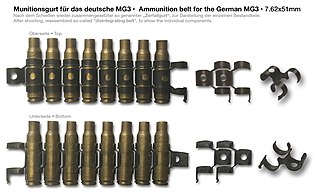
The M13 link, formally Link, Cartridge, Metallic Belt, 7.62mm, M13, is the U.S. military designation for a metallic disintegrating link specifically designed for ammunition belt-fed firearms and 7.62×51mm NATO rounds. It was introduced in the mid-20th century. It is the primary link type for the United States and among NATO for the 7.62×51mm NATO cartridge. As of 2017, it has been in use for over 60 years and is used on the Dillon M134D Minigun, M60 Machine Gun, FN MAG/M240, Mk 48, MG3, HK21, MG5, UKM-2000, K16, SS-77, and Negev NG-7, among others. Some countries redesignated the M13 link when it was adopted.
The Colt Machine Gun or CMG was an open bolt belt-fed machine gun that fires 5.56×45mm cartridges designed by Colt Manufacturing Company in 1965. Colt hastily developed the CMG-1 to complement the CAR-15, a Colt branding of the M16 rifle, so that Colt might offer both of them as an alternative to the Stoner 63 weapons system. It failed to achieve any sales, and was replaced by the Colt CMG-2, which also failed to achieve any sales. The CMG-3 was a 7.62×51mm NATO version that failed as well.

The M249 SAW, formally the Light Machine Gun, 5.56 mm, M249, is the United States Armed Forces adaptation of the Belgian FN Minimi, a light machine gun manufactured by FN Herstal (FN).
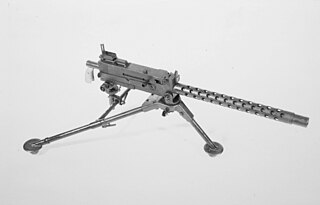
The M1919 Browning is a .30 caliber medium machine gun that was widely used during the 20th century, especially during World War II, the Korean War, and the Vietnam War. The M1919 saw service as a light infantry, coaxial, mounted, aircraft, and anti-aircraft machine gun by the U.S and many other countries.
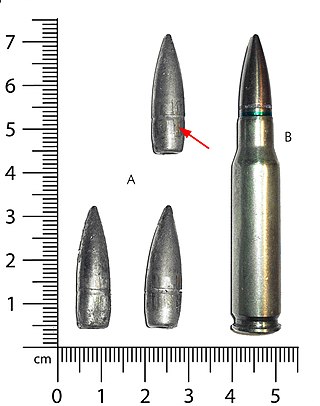
The 7.62×51mm NATO is a rimless, straight walled, bottlenecked, centerfire rifle cartridge. It is a standard for small arms among NATO countries.
The True Velocity RM338, formerly Lightweight Medium Machine Gun (LWMMG), is a prototype machine gun being developed first by General Dynamics, later by LoneStar Future Weapons, now by True Velocity. The weapon was originally developed by General Dynamics for Combating Terrorism Technical Support Office (CTTSO) Irregular Warfare program, but was later reintroduced by True Velocity for United States Special Operations Command (SOCOM) LMG-M program.
The SIG Sauer MG 338 is a medium machine gun manufactured by the SIG Sauer company.
